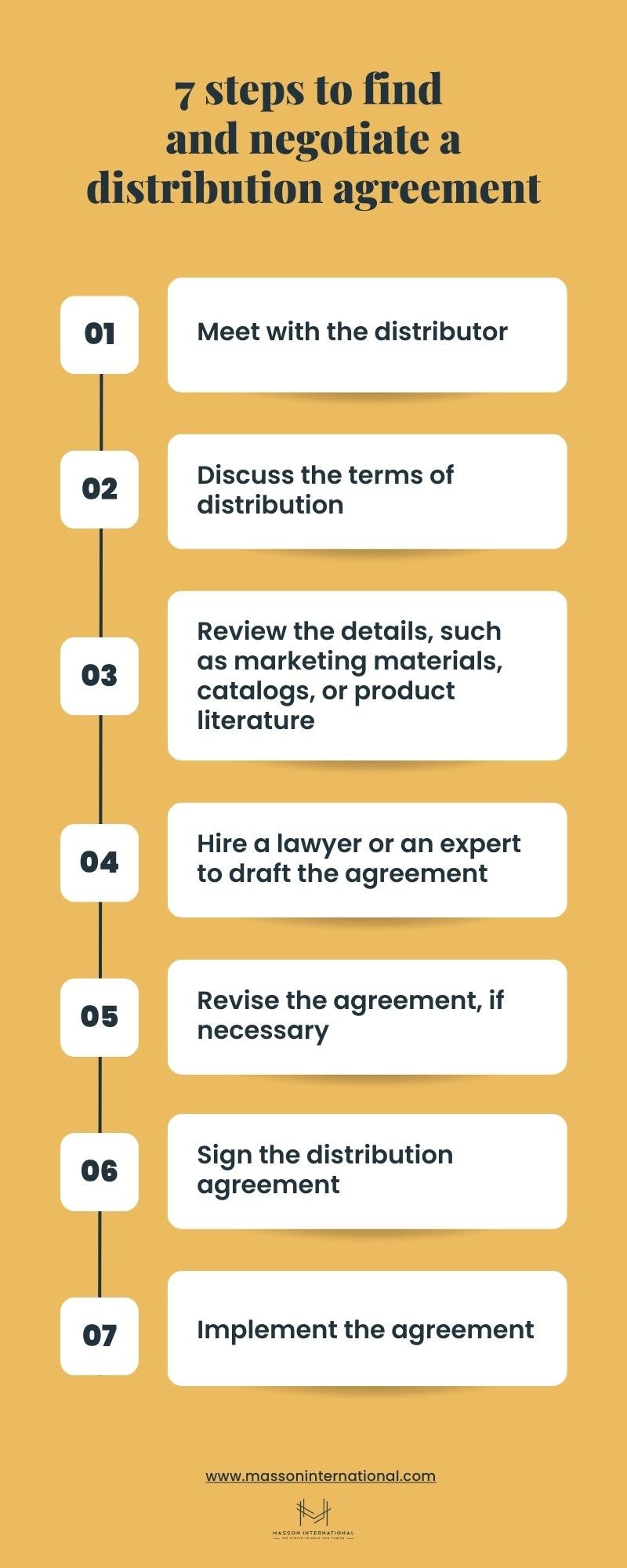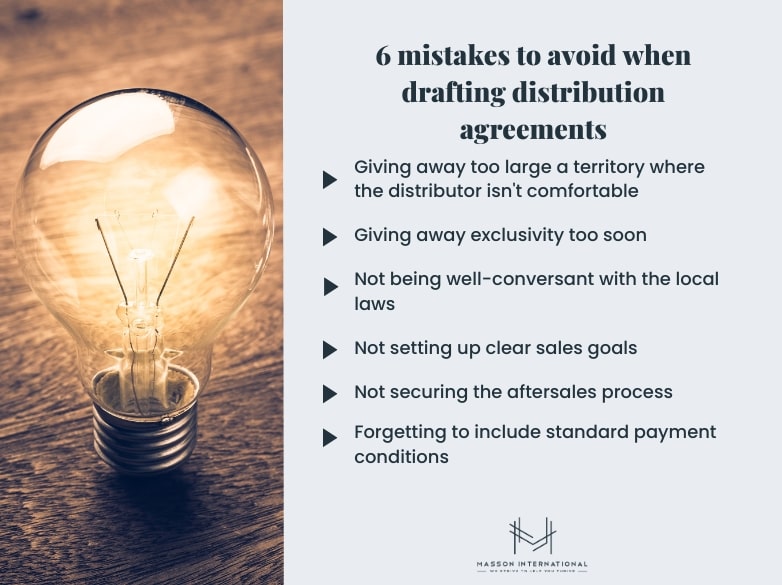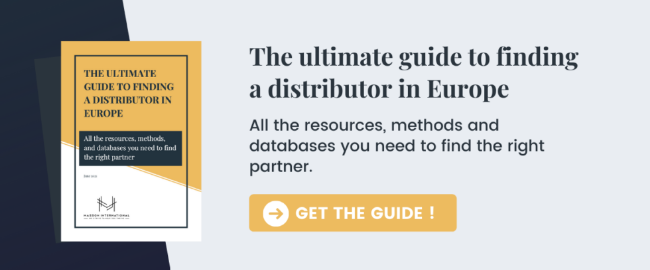Distribution agreements benefit distributors as well as manufacturers. Apart from laying the groundwork for a longstanding relationship, they also protect the interests and expectations of both parties.
However, a distribution agreement includes some risks and challenges, such as the potential for conflicts of interest, competition, or liability issues. This is why distribution agreements should be clear and comprehensive and leave no room for doubt or misunderstanding.
- What is a distribution agreement?
- Key components of a distribution agreement
- How distribution agreements work?
- Negotiating a distribution agreement
- Mistakes to avoid when drafting distribution agreements
What is a distribution agreement?
A distribution agreement is a contract between a manufacturer and a distributor. The manufacturer grants the distributor the right to sell its products or services in a specified territory or market. A distributor purchases goods, usually at a significant discount, and then sells them to the final customers by including their desired margin. A distribution agreement defines the terms and conditions and the scope of obligations for both parties.
Key components of a distribution agreement
A distribution agreement typically includes the following key components:
- Names and addresses of the parties involved: Every distribution agreement begins with the legal names and registered domiciles of the manufacturer and the distributor.
- Pricing and payment terms: This section sets out the prices of the products, the discounts or commissions that the distributor may receive, and the payment methods and schedules that both parties agree to follow. Some manufacturers may also include the maximum selling price at which a distributor is allowed to sell their products.
- Quality standards and warranties: A sound distribution agreement sets down the quality standards that the products must meet, along with the warranties a manufacturer provides to the distributor and the end customers. In some instances, the procedures for quality control, inspection, testing, and certification of the products are also included here.
- Marketing and promotion activities: Marketing and promotion strategies is another key component. It defines the marketing activities both parties will use to sell and distribute the products.
- Scope of the contractual obligations: This section describes the scope of the products that are covered by the agreement and the territories or markets in which the distributor is authorized to operate.
- Duration of the contract: The agreement must specify the effective date and the expiration date of the agreement, as well as the conditions for renewal or termination.
- Terms and conditions for sales and returns: This section sets out the terms and conditions that apply to the sales and returns of the products.
- Defects and returns provisions: Details about how both parties will handle defective or damaged products are also included. For example, provisions for inspection rights, notification requirements, remedies, or options available to either party, such as repair or replacement, refund or credit, etc.
- Severance terms: This section defines how both parties will end their relationship in case of termination of the agreement, along with provisions for early termination, notice periods, breach of contract, force majeure, and survival clauses.
- Dispute resolution mechanisms: Certain distribution agreements may comprise procedures to resolve any disputes or conflicts that may arise from the agreement, such as the provisions for negotiation, mediation, or arbitration, choice of law or jurisdiction, etc.
A distribution agreement is a complex and important document that requires careful drafting and negotiation. Both parties should consult with experts before signing it to ensure that their interests are adequately protected and that they comply with any applicable laws or regulations.
To get an idea of what a typical distribution agreement looks like, here is one available in the U.S. Securities and Exchange Commission archives.
This article might interest you ⤵️
How distribution agreements work?
A manufacturer appoints distributors to sell its products directly to retailers and consumers. The distributor bears the cost of sales, while the manufacturer benefits from the established reputation and demand for their products and services. The distributor’s goal is to make the most profit from the transaction, but this is largely subject to the terms and conditions of the sale.
How agreements work
Here are the steps to find and negotiate a distribution agreement:
- Step 1: Meet with the distributor
- Step 2: Discuss the terms of distribution
- Step 3: Review the details, such as marketing materials, catalogs, or product literature
- Step 4: Hire a lawyer or an expert to draft the agreement
- Step 5: Revise the agreement, if necessary
- Step 6: Sign the distribution agreement
- Step 7: Implement the agreement
Types of distribution agreements
There are different types of agreements with distributors, depending on the nature of the products or services to be distributed and the degree of control and risk that each party wants to assume. Here are some of the most common types of distribution agreements:
Product distribution agreement
A manufacturer grants the distributor the right to sell its tangible products to customers in a specified territory or channel. The distributor usually purchases the products from the supplier wholesale and resells them at a retail price, earning a margin. They may also provide after-sales services like installation, maintenance, or repair.
While distributors typically retain ownership of the purchased goods and do with them as they please, the manufacturer may retain the right to impose certain conditions. These could be anything from quality standards to pricing policies.
Service distribution agreement
This is the same as a product distribution agreement, but instead of a product, a distributor has the right to distribute service to customers in a specified territory or channel. The distributor acts as an agent or intermediary between the supplier and the customers, facilitating the delivery of the services and collecting payments. The distributor receives a commission or a fee from the supplier or the customers for its services.
Software distribution agreement
A supplier grants the distributor the right to distribute its software products in various forms, such as physical media, downloads, an iPhone or Android app, cloud-based services, or software as a service (SaaS). The distributor may charge customers a license fee or a subscription fee for using the software products.
Intellectual product distribution agreement
These agreements pertain to intellectual products that may include books, music, films, games, artworks, or other creative works. A distributor typically pays royalties or fees to the supplier for each sale or use of the intellectual property. The supplier retains ownership of the intellectual products and may impose copyright terms, moral rights, or other intellectual property rights on the distributor.

Negotiating a distribution agreement
Distributive negotiations can be rewarding for both parties when done well. To ensure that distribution negotiations end well, here are a few things that you can do:
Do your homework
Always do your due diligence and research before you step into a room. Research the market potential and demand and analyze the competitive landscape to see how a particular product or service stacks up. It would also be a good idea to look at the legal and regulatory environment as well as the cultural and business norms in the geographic areas. Also, make notes on the reputation and track record of a potential distributor and their financial stability.
Build trust and rapport
Distribution negotiations may not go the distance without trust and rapport. This makes it extremely vital to establish a rapport with your distributor by listening actively to their needs and concerns, acknowledging their achievements, and expressing appreciation and recognition. You should also demonstrate your credibility by showing your track record for consistent sales success, delivering on your promises, and addressing any issues or problems promptly and professionally.
Stick to your objectives and priorities
Always have a clear idea of what you want to achieve from the distribution agreement. You should also identify your non-negotiables and your trade-offs, as well as your best alternative to a negotiated agreement (BATNA). This will help you set realistic expectations and communicate them clearly to your counterpart.
Shoot for win-win solutions
The goal of successful distribution negotiations is to have both parties walk away from the table delighted. But for this to happen, you have to make efforts to understand the interests and motivations of your manufacturer, not just their positions or demands. Also, explore creative options and distribution alternatives that can satisfy both parties’ needs and expectations. For example, you could offer to share the costs or risks of marketing or inventory management.
Be flexible and adaptable
Negotiating a distribution agreement can be a dynamic and unpredictable process that requires adaptability and responsiveness. This is especially true if your discussions hit a roadblock. You should be prepared to deal with changing circumstances, new information, unexpected challenges, and unforeseen opportunities. If you continue to be too rigid or aggressive in your approach, this could damage the rapport and lead to a deadlock.
This article might interest you ⤵️
Mistakes to avoid when drafting distribution agreements
A distribution agreement can help expand the market reach and increase the sales of a manufacturer's products or services. However, a distribution agreement can also pose some risks and challenges for both parties if it is not well-negotiated and drafted. Every manufacturer should try to avoid making the following six mistakes:
1. Giving away too large a territory where the distributor isn't comfortable
A manufacturer may be tempted to grant a large or even global territory to the distributor, hoping to maximize the potential sales and revenue. However, this may backfire if the distributor is not familiar with or capable of covering such a large area. The distributor may face difficulties in marketing, logistics, customer service, and compliance in different regions or countries. The manufacturer may also lose control over the quality and consistency of its brand image and reputation across different markets.
Therefore, it is advisable for the manufacturer to grant a territory that matches the distributor's expertise, experience, and resources and to review and adjust the territory periodically based on the distributor's performance and market conditions.
2. Giving away exclusivity too soon
An exclusive distribution agreement means that the manufacturer agrees not to appoint any other distributors or sell directly to customers in the same territory as the distributor. It creates a strong incentive for the distributor to invest in promoting and selling the manufacturer's products or services.
However, an exclusive distribution agreement can also be risky for both parties if it limits the manufacturer's flexibility and market access and reduces the distributor's motivation and accountability over time. It's always a good idea to play it safe and avoid granting exclusivity too soon or too easily to the distributor unless there is a clear justification and benefit for doing so.
The manufacturer can also add some conditions and clauses to the exclusive distribution agreement, such as minimum sales targets, performance reviews, termination rights, and renewal options.
3. Not being well-conversant with the local laws
A distribution agreement is a legal document that binds both parties to comply with its terms and conditions. However, a distribution agreement may also be subject to various local laws and regulations that apply in the territory where the distributor operates.
These local laws and regulations may affect or override some provisions of the distribution agreement, such as those related to pricing, warranties, liability, intellectual property rights, dispute resolution, termination, and compensation. Roping in the services of a lawyer to read the agreement beforehand is crucial to avoiding future losses that may result from misunderstanding or misinterpreting local laws.
4. Not setting up clear sales goals
A distribution agreement is the perfect place to establish the sales goals and expectations for both parties. The manufacturer wants to ensure that the distributor will actively promote and sell its products in the designated territory or channel and generate a certain level of revenue and profit. The distributor wants to have a clear idea of what the manufacturer expects from it and what incentives and rewards it can receive for achieving or exceeding the sales targets.
By setting up clear sales goals in the distribution agreement, you can:
- Align your expectations and interests with your distributor
- Motivate your distributor to perform well and reward its efforts
- Monitor your distributor's progress and performance
- Adjust your strategy and tactics if needed
5. Not securing the aftersales process
Another important aspect of a distribution agreement is the aftersales process. The aftersales process refers to the activities and services that the manufacturer and the distributor provide to the customers after they purchase the products, such as:
- Warranties and guarantees
- Maintenance and repair
- Technical support and training
- Spare parts and accessories
- Customer feedback and complaint handling
The aftersales process is crucial for ensuring customer satisfaction and loyalty, as well as enhancing your brand's reputation and image, which is why it is a vital part to include in a distribution agreement.
By securing the aftersales process in your distribution agreement, you can:
- Ensure customer satisfaction and retention
- Protect your product quality and brand image
- Reduce potential disputes and liabilities with your distributor and customers
- Identify areas for improvement and innovation
6. Forgetting to include standard payment conditions
The last mistake that manufacturers should avoid in a distribution agreement with a distributor is forgetting to include standard payment conditions. These refer to the terms and conditions that govern how and when the manufacturer will receive payment from the distributor for supplying its products. The payment conditions are vital for ensuring cash flow stability and security for both parties.
Hence, you need to include standard payment conditions in your distribution agreement with your distributor.

Conclusion
A distribution agreement can help a manufacturer expand its market reach, increase its sales volume, and reduce its operational costs. However, it also involves some risks and challenges, as well as legal compliance issues in different jurisdictions.
A manufacturer should carefully evaluate the benefits and drawbacks of entering into a distribution agreement and negotiate the best possible terms with the distributor to protect its interests and achieve its business goals.







